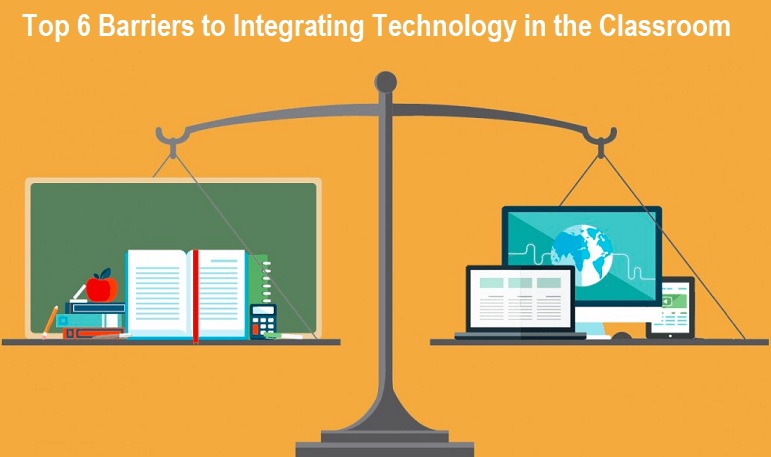As the implementation of technology in the classroom of schools, colleges and universities continue to accelerate, institutes that are yet...
As the implementation of technology in the classroom of schools, colleges and universities continue to accelerate, institutes that are yet to execute some of the latest tech innovations in their classrooms are feeling the pressure to align with the trend. Although gadgets can improve learning and make the work of teachers easier and more effective, there have been some notable challenges and barriers. Here are some notable problems that can be encountered as a result of using tech in the classroom.

Digital education is currently creating immense learning prospects as students can engage online and with ease. As faculty create new instructive practices through individualized teaching, novel teamwork models, and hybrid courses, the ability of technology to shape learning becomes even more crucial.
In this context, digital education implies the innovative utilization of technology and digital tools in the process of learning and teaching. By embracing the use of digital educational technologies, teachers are able to design engaging opportunities for learners to take part in the courses being taught.
In practice, most teachers struggle with technology, as well as with the numerous disruptions associated with gadgets. In fact, many instructors view new tech as a future barrier to effective teaching.
Although technology comes with many benefits for everyone involved in the education sector, there are some challenges that require attention. School administrators and educators have a responsibility to offer technical training and support, ensuring the seamless integration of digital technology without interfering with the goals of instruction.

What Does Classroom Technology Mean?
Today, most students get into the education system when they already know how to use computers and other technological devices. They grow up in technology, and the gadgets are woven into all aspects of the social and academic lives. Also, being technologically savvy is one of the basic requirements in the modern workplace, which makes it critical to foster digital education.Digital education is currently creating immense learning prospects as students can engage online and with ease. As faculty create new instructive practices through individualized teaching, novel teamwork models, and hybrid courses, the ability of technology to shape learning becomes even more crucial.
In this context, digital education implies the innovative utilization of technology and digital tools in the process of learning and teaching. By embracing the use of digital educational technologies, teachers are able to design engaging opportunities for learners to take part in the courses being taught.
Digital Technology Challenges for Instruction
One reason why most teachers find integrating technologies in classrooms challenging is the feeling that they ought to transform into digital experts. There is no doubt that educational tech plays an important role in improving instruction by facilitating access to instruction and enhancing communication. However, although the students may be digital natives, they still rely on teachers to offer guidance.In practice, most teachers struggle with technology, as well as with the numerous disruptions associated with gadgets. In fact, many instructors view new tech as a future barrier to effective teaching.
Top 6 Barriers to Integrating Technology in the Classroom
Here are some common barriers and challenges:1. Differences in Device Capabilities
In some cases, schools ask learners to carry their own devices to class, which raises an equity problem. There can be differences in the capabilities of the gadgets, while some learners may not be able to afford the tech. Teachers may also have to offer multiple instructions on how to use different devices.2. Problems with Cheating
It has also been argued that technology facilitates cheating in tests and assignments. Today, all that a student needs is an internet connection to seek professional writing help from a custom paper writing service online. It has created a new challenge for educators, pushing colleges to use plagiarism detection tools and other measures to curb academic dishonesty.3. Cases of Distraction
Digital technology can be a source of distraction during learning time. Students often use their devices for playing and going on social networking sites like Facebook and LinkedIn. When the gadgets are introduced into the classroom, issues of using them for non-academic purposes arise during class time.4. Interference with Lesson Flow
Technological devices and applications are prone to hiccups. Lessons can easily get interrupted as teachers work with technicians to correct problems, thereby reducing instruction time. Also, teaching students how to use applications and gadgets, as well as preparing lessons to integrate tech, can be time-consuming.5. Lack of Sufficient Skills and Manpower
Technology is always changing, and keeping up can be a challenge. Even when teachers have been trained on how to use specific devices and applications, they would need continuous training as changes occur. Also, schools need information technology systems and personnel if they are to benefit from digital capabilities fully. All this can be costly and time-consuming, taking attention away from curricula. Without proper training and staff, however, new investments in tech end up being underused or misused.6. Challenges Relating to Teacher Beliefs
Not all teachers believe that technology is beneficial to education. If the teacher is not convinced of the importance of innovation, he or she will not be able to transform the classroom and align the digital technology with learning goals. Also, teachers have a responsibility to protect students’ behaviors as they interact online.Although technology comes with many benefits for everyone involved in the education sector, there are some challenges that require attention. School administrators and educators have a responsibility to offer technical training and support, ensuring the seamless integration of digital technology without interfering with the goals of instruction.







COMMENTS